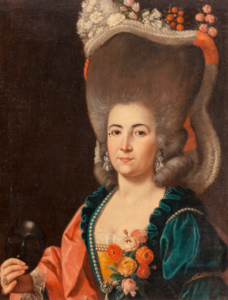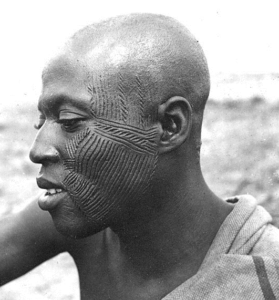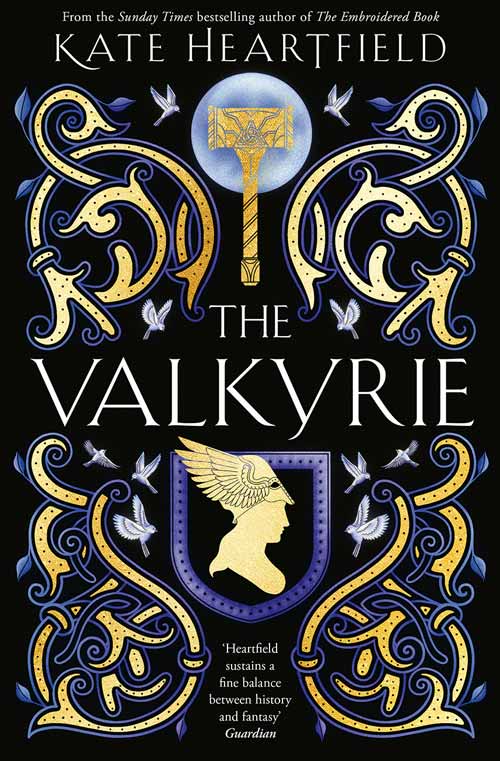More Historical Body Modifications: Hairstyles, Piercing and Footbinding

Roman fresco of a woman wearing a garland of olives, from Herculaneum. Source: Wikimedia Commons
BY B.J. SEDLOCK
Building on my previous article from 2021, here are some more historical body modifications you might want to research for characters in the novel you are working on. Also, browsing this list might give you story ideas. Books are listed first, then websites.
HISTORICAL HAIRSTYLES—BOOKS
Hair: An Illustrated History, by Susan J. Vincent. Bloomsbury Visual Arts, 2018. 9780857851710
“Examine[s] in a historical frame the key ways that [hair] has been managed over the last five hundred years, and how these can help illuminate broader social developments and cultural processes”—introduction. It’s not arranged chronologically, but in themes, such as hair removal over the centuries, relations between clients and barbers/hairdressers, facial hair going in and out of fashion, etc. An index will help you find the section you need, and an extensive bibliography will point you to other resources. Lavishly illustrated.
Fashions in Hair: The First Five Thousand Years, by Richard Corson. Peter Owen, 2001. 0720610931
This was originally published in 1965 and reprinted many times between then and the edition I examined. The author’s first intent was to provide illustrations of historical hairstyles for use by theaters producing historical plays, but it evolved into a general book about historical hair in the Western world. It’s arranged chronologically, starting with ancient Egypt and Biblical times, through the end of the 20th century. The black and white illustrations include a multitude of line drawings of hairstyle examples, all dated and with country of origin if known. It has an index and bibliography.

Hairstyles of Black laborers in Brazil, 1830-1840. Library of Congress Control Number 89711226
Twisted: The Tangled History of Black Hair Culture, by Emma Dabiri. HarperPerennial, 2020. 9780062966728
The historical content is not presented chronologically, and there’s no index, so researchers may have to do some skimming to find the sections they are looking for. “Dabiri takes us from precolonial Africa, through the Harlem Renaissance, and into today’s Natural Hair movement.”—back cover. She mixes historical content with her own personal experiences, looking at racism, politics, and the history of attitudes towards Black hair. It includes an extensive bibliography.
A Century of Hairstyles, by Pamela Church Gibson. Shire Publications, 2014. 9780747813729
This small book doesn’t cover the topic in depth, but if you want a sampling of men’s and women’s hairstyles popular in the 20th and first decade of the 21st centuries, it would be a good volume to leaf through for ideas. Illustrations are heavy on photos of celebrities and their signature hairstyles, starting with the Gibson Girl in 1905 through 2010. There’s no bibliography.
Daring Do’s: A History of Extraordinary Hair, by Mary Trasko. Flammarion, 1994. 208013549X
The author concentrates on extreme women’s hairstyles over the centuries, starting in ancient times. It’s well-illustrated with historical images, and the text provides context to the pictures. Bibliographical notes provide further research leads.
Hairstyles: Ancient to Present, by Charlotte Fiell. Fiell Publishing, 2010. 9781906863104
This large, thick volume is mostly illustrated examples of women’s hairstyles since ancient times, though the bulk of the material is from the 18th to 21st centuries. “Hairdressing is and always has been a vibrantly creative discipline, as well as a barometer of the wider cultural landscape in which it exists”—introduction. If you have no idea what hairstyle to give your heroine, this book provides a lot of period examples to choose from.

Farmer viewing his son’s elaborate hairstyle and the latest fashions, 1774. Library of Congress Control Number 95513751
Encyclopedia of Hair: A Cultural History, by Victoria Sherrow. Greenwood Press, 2006. 0313331456
While it has some illustrations, this is mostly text about “the care and appearance of the hair (both head and body) and on the social-historical, health-related, age-related, regulatory, and other non-utilitarian aspects of grooming hair and dealing with facial and body hair”—preface. It’s alphabetical by topics, such as Afros, bangs, body hair, dreadlocks, hair coloring, lice, permanents, and shaving. It covers non-Western hair practices with country entries for China, Japan, and India. A very lengthy bibliography will point you to further research sources.
Hair: Untangling a Social History, by Penny Howell Jolly. Frances Young Tang Teaching Museum and Art Gallery at Skidmore College, 2004. 0972518835
This is a catalog of an exhibit at the museum held in the first half of 2004. Essays accompanying the color illustrations include men’s hair fashions, the sociology of baldness, ideals in women’s hair in different centuries, body hair, and the social power of hair. Each essay includes bibliographical notes, and the end has a list of all the objects in the exhibit.
The American Duchess Guide to 18th Century Beauty: 40 Projects for Period-Accurate Hairstyles, Makeup and Accessories, by Lauren Stowell and Abby Cox, with Cheyney McKnight. Page Street Publishing, 2019. 9781624147869
Historical costumers offer this guide to 18th century styles for women: period haircare and hygiene, plus recipes for accessory items like hair powder and lip salve. You may not want to dress in 18th century garb yourself, but this book offers step-by-step methods of creating 18th century coiffures, which might be useful in a novel’s scene where your character’s maid is doing her hair for a party. The authors state that they present historically accurate methods.
Historical Wig Styling [2 vols.]:
Ancient Egypt to the 1830s 9780240821238, and
Victorian to the Present 9780240821245, by Allison Lowery. Focal Press, 2013.
These two volumes are aimed at theatrical costumers and cosplay fans, among others, but might still be useful for historical novelists. Lowery provides photos of step-by-step processes of creating historical hairstyles on wigs, and lists of tools needed to produce them. Artwork from the particular period giving examples of historical hair are also included. However, an Elizabethan-era maid, say, would not have had access to plastic hair rollers as in these examples, so use the information here with caution in your novel. A few non-Western styles are included in volume 2.

Follower of Roslin – Portrait of a Lady with her Hair Adorned with Flowers, Holding a Mask, 1770-1785.Source: Wikimedia Commons
HISTORICAL HAIRSTYLES—WEBSITES
I chose not to list a multitude of .com websites that are trying to sell users something, even if they had some historical content.
Hairstyles in the Ancient Roman World (Early Church History)
Gives an overview of hairstyles in the Roman empire, with illustrations from period art.
This scholarly essay originally appeared in the December 1994 issue of East Asian History. It covers the social history of wearing the queue in China, and offers lengthy bibliographical notes.
The Huge History of Big Hair Bows (University of Sydney)
This website from the University of Sydney in Australia provides an overview of the popularity of hair bows over the centuries, used by both men and women in various eras.
PIERCING AND SCARIFICATION—BOOKS

African scarification in the early 1940s (detailed). Source: Wikimedia commons
These topics are difficult to find a lot of material on; especially scarce are non-commerical websites.
A Brief History of the Evolution of Body Adornment in Western Culture: Ancient Origins and Today, by Blake Andrew Perlingieri. Tribalife Publication, 2003. 0867196084
“Historically traces and outlines a cross-cultural and global overview of the body art of piercing…”—foreword. Historical coverage is included, such as examples of Pre-Columbian earplugs, but quite a bit of the content is essays and photographs of modern-day body mods. And despite the title, it does cover some non-Western cultural practices. Includes a brief bibliography.
A Cultural History of Body Piercing, by Bonnie Szumski and Jill Karson. Reference Point Press, 2014. 9781601525581
Despite the title, more of this book covers present-day piercing practices than historical, and seems to be aimed at young adults. A lot of the text is about motivations for piercing and other body mods. It includes bibliographical notes.
Encyclopedia of Body Adornment, by Margo DeMello. Greenwood Press, 2007. 9780313336959
Look for entries such as “ear piercing,” “ear spools,” “scarification,” in this dictionary-format book. Since it covers all body adornment, there is extensive coverage of tattooing, makeup (topics I covered in a previous article) and other body mods. It has a lengthy bibliography for further research.
Spiritual Tattoo: A Cultural History of Tattooing, Piercing, Scarification, Branding, and Implants, by John A. Rush. Frog Ltd., 2005. 1583941177
“This book is about the human body as a vehicle for purging emotional and physical issues as a preparation for a spiritual life”—preface. There is historical coverage but a lot of the text is about present-day body mods, too. It has a substantial bibliography for further research.

Brooklyn Museum 69.168.2 Mask Mwana Pwo, 19th century, showing scarification marks. Source: Wikimedia Commons
PIERCING AND SCARIFICATION—WEBSITES
An overview of piercing from an anthropological point of view.
Scarification (Pitt Rivers Museum, University of Oxford)
Another overview from an anthropological point of view. Includes links to pages on scarification practices in several African countries, plus Oceania.
FOOTBINDING—BOOKS
Aching for Beauty: Footbinding in China, by Wang Ping. University of Minnesota 2000. 0816636052
The author offers a cross-cultural and interdisciplinary discussion of the practice of footbinding in China in historical times. “History, literature, linguistics, and psychoanalysis [are] crucial to a comprehensive understanding of this cultural fetish”—preface. Chapters examine foot and food fetishes, footbinding’s use in erotica, and references to the practice in literature. A bibliography is included.
Chinese Women and Rural Development: Sixty Years of Change in Lu Village, Yunnan, by Laurel Bossen. Rowman & Littlefield, 2002. 0742511073
Chapter three has the most information on footbinding, in one rural village. The author argues that footbinding declined largely due to economics, when the industrial revolution in textiles led to “the demise of the domestic textile industry of spinning and weaving”—p. 352-353. The chapter ends with helpful, extensive footnotes.

Foot binding shoes, 1911. Source: Wikimedia Commons
Footbinding and Women’s Labor in Sichuan, by Hill Gates. Routledge, 2015. 9780415525923
“This study examines footbinding as living Sichuan women remember it from the final years of the empire and the troubled times before the 1949 revolution”—p.1. Gates does not explore the entire history of footbinding, but instead focuses on one region of China and the effect it had on labor and society between 1854-1954. An extensive bibliography is included.
Kecantikan bengkung kaki = The allure of the bound foot, by Susanna Goho-Quek, Karen Quek, Kenneth Quek. Dept. of Museums and Antiquities, Malaysia in collaboration with Masplea (M), House of Suziewong, 2004. 9679935361
This contains photographs of shoes made for women who bound their feet, from an exhibit in Malaysia. The text is in Malay and English. “The focus of the exhibition is an appreciation from an artistic point of view, but with an emphasis on the women who created them and their inspiration and motivation”—p.42. Personal stories are part of the text, and a chart of symbols giving meanings of objects embroidered into shoes are also included. For example, a duck represented fidelity, a narcissus, good fortune.
Splendid Slippers: A Thousand Years of an Erotic Tradition, by Beverly Jackson. Ten Speed Press, 0898159571
“An aesthetic, highly personal, and deeply respectful exploration of the facts and the fiction surrounding” footbinding—front flap. The author is a textile collector and got interested in the topic when she began collecting shoes made for women with bound feet. Historical photographs of women with bound feet are included as well as examples of the shoes. A bibliography is included.

The so-called “lily feet” contrasted with the natural feet of Chinese women, Canton, China, 1902. Library of Congress Control Number 2006685954.
FOOTBINDING—WEBSITES
Foot-binding (World History Encyclopedia)
Gives an overview of the topic, with an illustration of what the practice did to the bones of the foot.
Why Footbinding Persisted in China for a Millennium (Smithsonian Magazine)
“A small foot in China, no different from a tiny waist in Victorian England, represented the height of female refinement…The fact that it was only performed by Chinese women turned the practice into a kind of shorthand for ethnic pride.”
The Peculiar History of Foot Binding in China (The Atlantic magazine)
The Atlantic reporter interviewed the author of Aching for Beauty (see above in book listings) to get an overview of the topic.
Dorothy Ko offers a PDF essay from the academic Journal of Women’s History on the difficulties of studying footbinding as a historian: “There is no neutral or objective knowledge about footbinding.” As one would expect from an academic journal, it has a lengthy bibliography.
About the contributor: B.J. Sedlock is Lead Librarian and Coordinator of Metadata and Archives at Defiance College in Defiance, Ohio. She writes book reviews and articles for The Historical Novels Review, and has contributed to The Sondheim Review.






